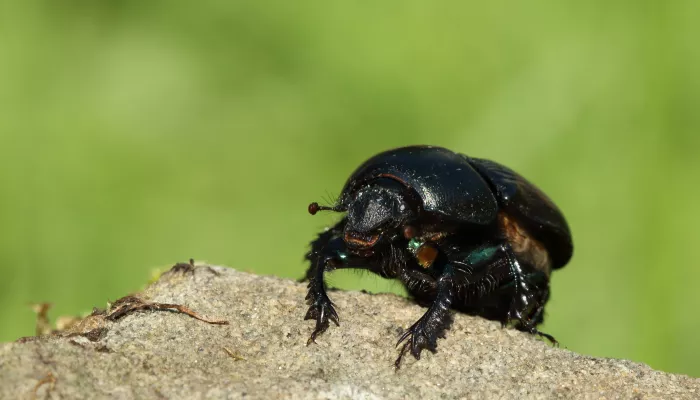These often overlooked or simply unnoticed insects prove that you don’t have to be the size of a European bison to have a landscape-scale impact. Also deemed an ‘ecosystem engineer’, the humble dung beetle, when in healthy numbers, performs an incredible array of natural functions that underpin soil health and support a large range of animal and plant life (boosting biodiversity).
There are over 60 species of dung beetle to be found in the UK, which make up three main groups.
- Aphodiines (‘dwellers/ stealers’): Comprising of around 40 species living within the dung itself. Their C-shape larvae can be seen under the ‘cap’ of the dung.
- Onthaphagus (‘tunnellers’): Tunnelling down under the pat and taking pieces of dung with them within which they lay their eggs.
- Geotrupes (‘tunnellers’): These are larger tunnelling dung beetles (8-26mm in length).
All dung beetles eat dung, but some are ‘specialists’ and prefer specific types of animal dung, while others are ‘generalists’ and are happy to consume and inhabit a wide range of animal droppings, from deer to donkey and rabbit to Rottweiler. It is both the variety and abundance of these creatures that is important to supporting good soil health and biodiversity.
Tiny parcels of walking protein
Dung beetles are an attractive morsel of food to myriad other animals and their presence supports populations of bats, hedgehogs, owls, starlings, and many more of our native species. They are at their largest during their larval stage, when species such as the red-billed chough will probe into dung to extract them as a calorie-rich food source.
The dung beetle and farming
Amazingly, it is estimated that dung beetles provide a natural ecosystem service to the UK cattle industry valued in the hundreds of millions of pounds per year, in dung removal alone. Their actions also help aerate soil, decrease compaction, reduce erosion & flooding, recycle nutrients back into the soil, and help reduce parasite burdens in livestock.
Threats
Like most other insects, dung beetle numbers have declined dramatically in recent years. It is thought that some of the reasons for this include change of land use (i.e. removal of grazing animals) and the use of livestock veterinary treatments (e.g. worming chemicals that pass into the dung).
What can we do to help?
Kent Wildlife Trust has been working with farmers, land managers, equestrians, and vets to discuss options for supporting beneficial populations of dung beetles. These conversations have included considering more targeted parasite treatments (e.g. via faecal worm egg counts) as well as the potential to, where appropriate, leave some animals (and therefore dung) outside year-round.

